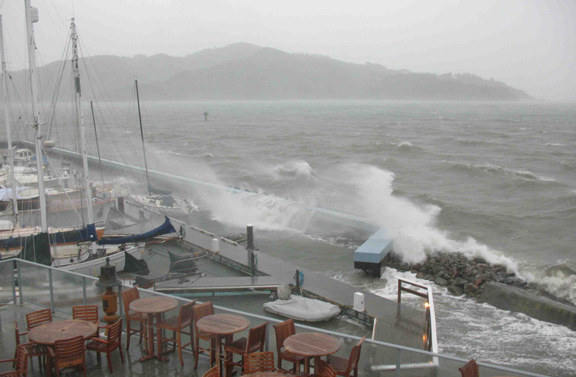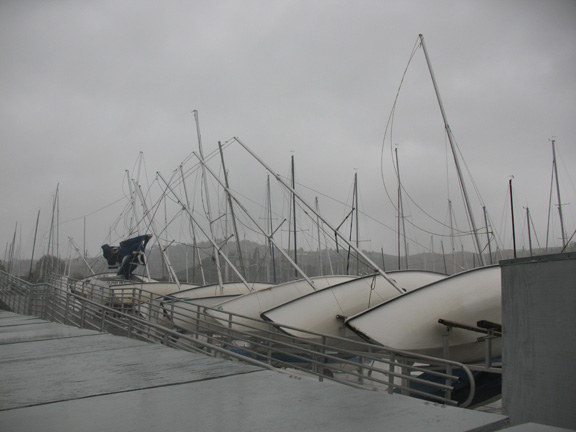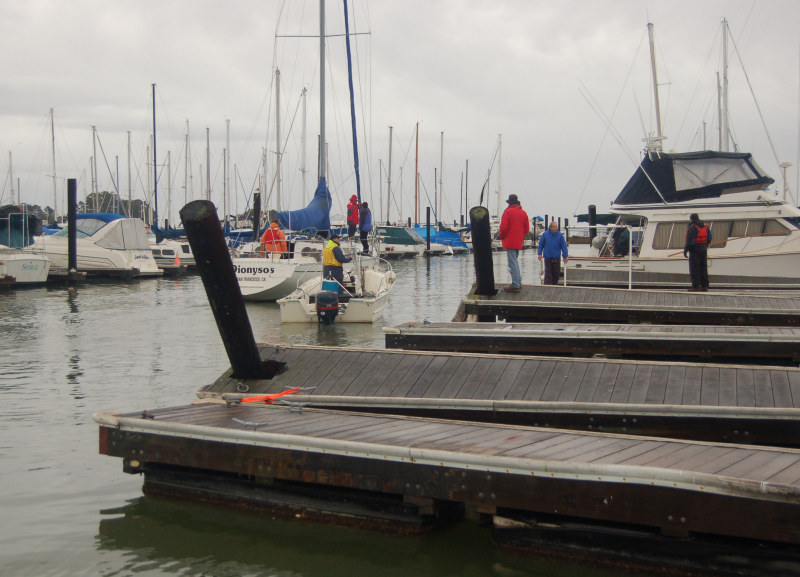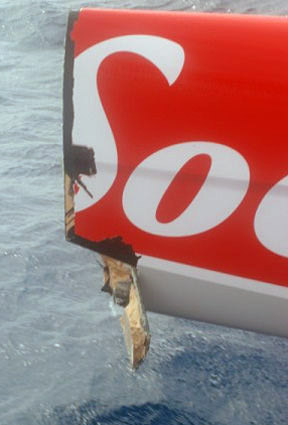
Mighty Storms Ravage Bay Area

© Latitude 38 Media, LLC
The full force of Mother Nature’s fury was felt throughout the San Francisco Bay Area last Friday and Saturday as torrential rains and hurricane-force winds lashed the region.

© Latitude 38 Media, LLC
Ashore, as roadways flooded, trees toppled into powerlines and semi tractor-trailers were tossed onto their sides atop Bay Area bridges, boaters throughout the region scrambled to save boats from storm-inflicted damage. At the height of Friday’s storm, the Richardson Bay anchorage, which lies between Sausalito and Belvedere, was a teaming cauldron of chaos, with sustained SW winds over 60 knots and gusts into the 70s. Local diver Todd Estrella was one of several local mariners who were attempting to keep moored boats from washing ashore. At some point, while working another rescuer, their rescue boat became unattached from a tug they were aboard while trying to save it. According to Todd’s brother, the dinghy Todd jumped into to go after the rescue boat capsized. He held onto the side for 45 minutes before being pulled from the water. Tragically, he later died in a Marin hospital.

© Latitude 38 Media, LLC
Elsewhere, marina staffs, liveaboards and other slipholders worked furiously to secure boats and gear throughout the Friday storm and during a smaller storm which followed on Saturday. Predictably, poorly secured roller-furling jibs led to dozens of boats lashing about wildly in their slips. At San Rafael’s Loch Lomond Marina wind-driven storm surge overran the outer breakwater and caused an entire row of docks to shift 30 feet. Amazingly, there was little or no boat damage. Loose gear in dry storage yards around the Bay Area became projectiles, as dozens of boats were toppled — especially lightweight daysailers.
Now that the electricity is back on at our Mill Valley offices, we’re beginning to receive photos and ‘war stories’ from all over the Bay Area. If you have storm-related photos or a pertinent report to share, please contact us. Look for further coverage here, and in the February edition of Latitude 38.
Coville Out, Joyon Gaining Pace
Just minutes after setting a new 24-hour solo record, an encounter with an unidentified floating object forced Thomas Coville’s 105-ft trimaran Sodeb’O to retire from its singlehanded round-the-world attempt. After covering 619 miles at an average speed of 25.8 knots, Coville reports he was down below when he felt the boat slow dramatically — no doubt from the drag resulting from the absence of the starboard ama’s sacrificial ‘crash box’.

"I immediately went on deck and a saw a plume of water, which was nearly 10 feet above the starboard float, " Coville told his shore team. "In a matter of seconds, you understand what’s happening without knowing how."
Coville expressed doubt that the damage was a result of a collision with a growler, as has been widely reported.
"A few moments later, I saw a piece of ice, but I think the impact would have been more severe, more violent if I’d hit ice," he said.
Coville is now halfway between the Kerguelen Islands and Cape Town in South Africa. His intent is to sail the 1,300 miles back uphill to Cape Town, and subsequently back to France, where his sponsor Sodeb’O, a French food company, has expressed support for another go around-the-world.
Meanwhile, Francis Joyon and IDEC anticipate getting into the South Atlantic trades soon, after fighting through a debilitating St. Helena High that’s slowed his progress for the last few days. Despite being hampered by the weather, Joyon is still well ahead of the current record pace and expressed dismay at Coville’s retirement.
"I’d like to congragulate Thomas on having taken the 24 hour record from me," Joyon said. "I imagine that Thomas must feel frustrated, and personally I am disappointed to have lost a competitor and the sporting motivation that this represents."
More on Darla Jean
When we receive reports of boats washing up on distant shores, we do our best to verify as many facts as possible but often must rely on eyewitness reports. Unfortunately, we are sometimes given inaccurate or incomplete information, as was apparently the case with Darla Jean.
In the January issue of Latitude 38, we reported that Jerry and Darla Merrow drifted across the Pacific and ran their boat onto a reef off Fanning Island. There were a few minor discrepancies in the story — they ran aground on December 4, not December 2, as reported; the first Darla Jean was a motorsailer, not a trimaran; she was 48 feet, instead of 47; and nothing happened to their first boat’s keel, it was the mast step that had a problem — but, according to Jerry Merrow himself, the biggest discrepancy, and the one that hurt the most, was the portrayal of his sailing experience. "I’ve been sailing since 1978," the 54-year-old Merrow told us this morning by phone. "I’ve sailed a 26-ft Piver from San Francisco to Honolulu, circumnavigated twice and have been to Mexico more times than I can count." In addition to the most recent Darla Jean, Merrow reports having owned at least 15 other sailboats at one time or another.
So how did they end up on Fanning Island? Merrow explained that he spent two years and nearly $200,000 outfitting the first Darla Jean, a Rudy Cheoy catamaran, for their cruise. "I totally upgraded the boat," Merrow told us. "New mast, new rigging, the whole lot. We weren’t far from the Bay when the deck around the mast step tore off. It was the only thing on the boat that I took for granted." Instead of spending time repairing the deck — "We were ready to go," Merrow said — the couple bought the next Darla Jean, a 48-ft custom motorsailer, and took off in late September.
"About 1,200 miles out of Moss Landing, we went through a four day storm — 40 knot winds and probably 20-ft seas," Merrow recounted. "We were going downwind so we didn’t notice any problems — other than we lost our autopilot, tore the mainsail and the engine wouldn’t start because it was swamped in water." But when the couple changed course for Hawaii, they noticed that while the boat turned, they were still moving in the same direction as before. At first Merrow thought they were stuck in a current but then a quick dive confirmed that most of the boat’s keel was missing. "We had a wind generator, solor panels, watermaker and lots of provisions, and we weren’t in any hurry, so it was no big deal," he told us.
On day 94 of their voyage, 110 miles from Christmas Island, they did find a nasty current that cut their speed so dramatically that they were only making about 50 miles per day. The current and wind forced them to alter course toward Fanning Island. Not expecting to visit Fanning, the couple didn’t have a chart but hoped that a lat and long that was handwritten in a book about the island was accurate. They plugged it into the GPS and hoped for the best.
"We saw three cargo ships and a Coast Guard boat a few days before hitting Fanning," Merrow reported. "We know our radio was working because we talked to one of the cargo ships, but the Coast Guard wouldn’t respond to our calls. We tried all day." As they closed in on Fanning, they tried calling island officials but had no luck there either. "Later we found out that the police have a VHF radio but no antenna so we gave them ours," Merrow said.
After spotting the island, the couple knew they were close — probably 14 miles or so. Merrow reported waking at 5 a.m., taking a futile look outside in the dark, and checking the radar which showed nothing at all. "I went to make some coffee and mess with the radar," he said, "then we hit the reef. We hit sideways, then the bow spun around into the coral." The couple had to jump into the 12-ft breaking swells to make it ashore, a 200 yard swim in black and unknown waters. Merrow reports that while swimming through the swells — Gulliver the parrot firmly planted on his shoulder — his passport fell out of his shirt pocket, which caused him no end of trouble with the local authorities.
There’s much more to the story, including the generous Mormon missionaries who hosted Jerry and Darla on Christmas Island, the Air Pacific pilot who passed the hat for the couple on the flight to Honolulu, the hotel that gave them a room at a ridiculously low rate, and the friends and family here in the Bay Area helping them out. We hope to share more in the next issue of Latitude.
